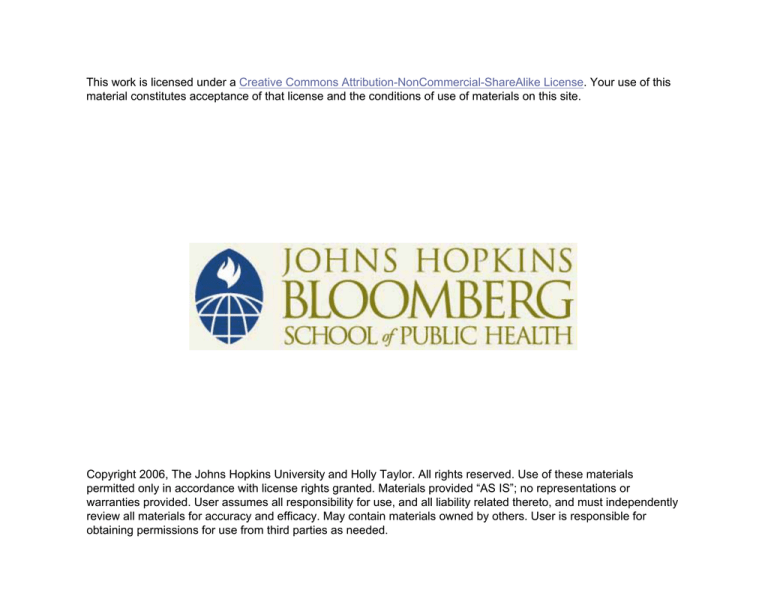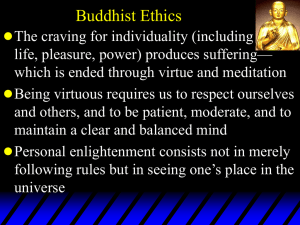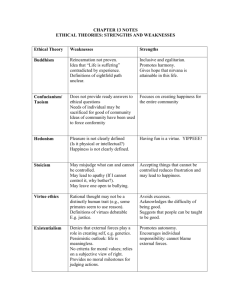
This work is licensed under a Creative Commons Attribution-NonCommercial-ShareAlike License. Your use of this
material constitutes acceptance of that license and the conditions of use of materials on this site.
Copyright 2006, The Johns Hopkins University and Holly Taylor. All rights reserved. Use of these materials
permitted only in accordance with license rights granted. Materials provided “AS IS”; no representations or
warranties provided. User assumes all responsibility for use, and all liability related thereto, and must independently
review all materials for accuracy and efficacy. May contain materials owned by others. User is responsible for
obtaining permissions for use from third parties as needed.
Ethical Analysis
Holly Taylor, MPH, PhD
Johns Hopkins University
Ethical Analysis
Topics to be covered
– Introduction to ethics
– Framework for ethical analysis
– Supplementing the framework
3
Section A
Introduction to Ethics
Normative Ethical Theory
Person(s)
Actions
Consequences
Continued
5
Normative Ethical Theory
Virtue theory
Consequentialist theory
Non-consequentialist theory
6
Virtue Theory (Aristotle)
Focus on person
Cultivation of virtuous
traits
Image Source: www.epistemelinks.com
Continued
7
Virtue Theory (Aristotle)
“A just person—that is a person with the
virtue of fairness—not only has the
disposition to act fairly, but when so acting
has a morally appropriate desire to do so.
The person characteristically has a moral
concern and reservation about acting in a
way that would be unfair (p. 214).”
Source: Beauchamp, Tom L.(1991) Philosophical Ethics:
Introduction to Moral Philosophy
Continued
8
Virtue Theory (Aristotle)
Practical virtue
9
Consequentialism
(John Stuart Mill)
Focus on consequences of
action(s)
– Action(s) are right in
proportion as they tend
to promote happiness,
wrong as they tend to
produce the opposite of
happiness
Utilitarian
Image Source: www.philosophypages.com
Continued
10
Consequentialism
(John Stuart Mill)
Maximizing principle
Impersonal perspective
Continued
11
Consequentialism
(John Stuart Mill)
Utility can conflict with other values
– HIV vaccine example
12
Non-Consequentialism
(Immanuel Kant)
Deontologic
Focus on action(s)
taken
Motive to act
Image Source: www.artemis.austincollege.edu
Continued
13
Non-Consequentialism
(Immanuel Kant)
Categorical imperative
Respect for persons
– Individuals should not be treated simply as
means to an end
14
Section B
Framework for Ethical Analysis
Framework for Ethical Analysis
Belmont Report (1978)
Clinical practice vs. research
Three principles
1. Beneficence
2. Respect for Persons
3. Justice
16
Beneficence
Moral requirements
– Do no harm
– Maximize benefits/minimize harms
Continued
17
Beneficence
Practical applications
– Study design
– Risk/benefit ratio
18
Respect for Persons
Moral requirements
– Acknowledge autonomy
– Protect those with diminished autonomy
Continued
19
Respect for Persons
Practical Applications
Informed consent
1. Information
2. Comprehension
3. Voluntariness
Continued
20
Respect for Persons
Practical Applications
Informational privacy and confidentiality
– Primary data collection
– Secondary data analysis
21
Justice
Moral requirement
– Equals should be treated equally
– To each an equal share
– To each according to effort
– To each according to societal contribution
– To each person according to merit
Continued
22
Justice
Practical Applications
Fair procedures for selection of study
subjects
– Individual
– Social
Gender/minority equity
23
Supplementing Framework
Casuist perspective (Jonsen and Toulmin)
Relationship paradgim (King, Henderson,
Stein)
Continued
24
Supplementing Framework
Principlist Paradigm
Balancing principles
Ethical universalism
Atomistic focus
Relationship Paradigm
Layering of relevant
relationships
Context-based
Cross-cutting issues
Narrative focus
Continuity
Change
25
Summary
Goal—create thoughtful principlists
26






